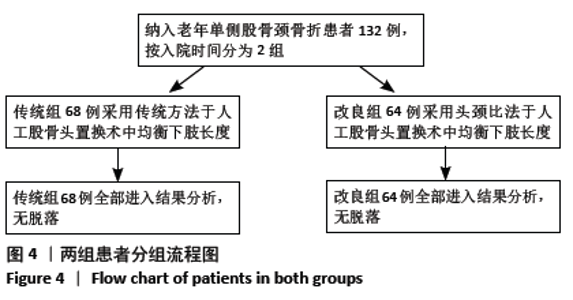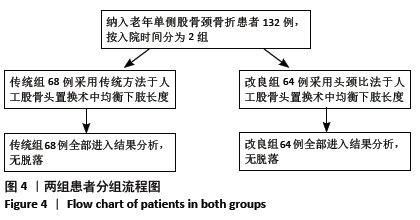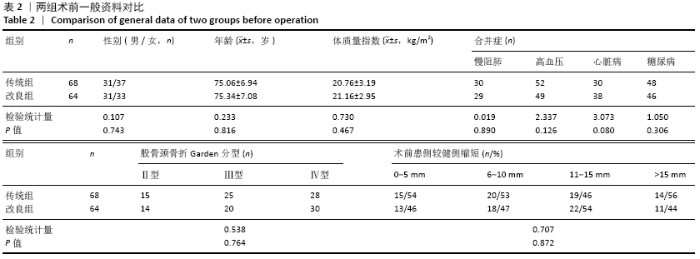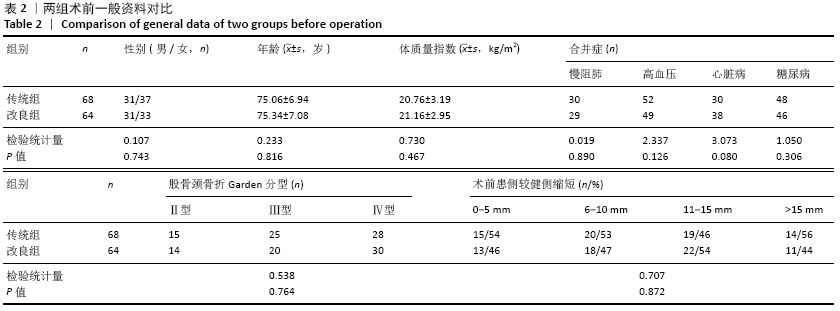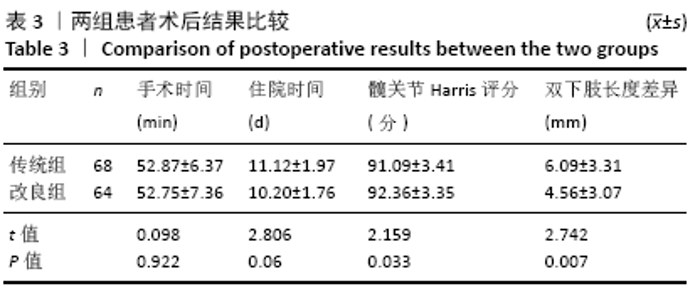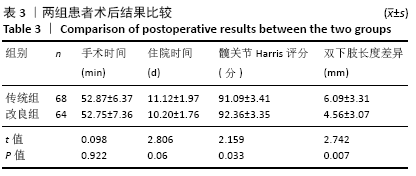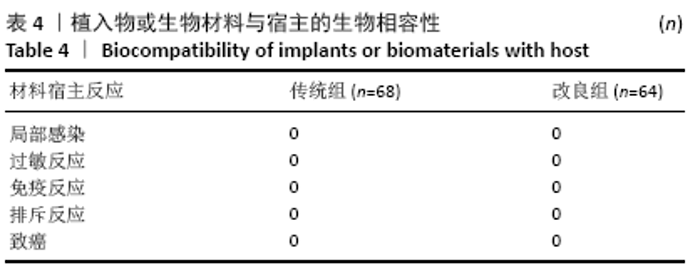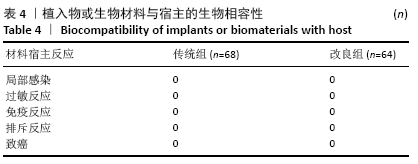[1] ZHOU Z, SHEN Y, HUANG S. A long-term study regarding the therapeutic effect of two titanium screw fixation for femoral neck fractures. Zhong Nan Da Xue Xue Bao Yi Xue Ban. 2015;40(2):182-187.
[2] LIN XB, WANG JR, LI CD, et al. Minimally invasive cemented and uncemented hemiarthroplasty for femoral neck fracture in the elderly. Chin J Bone Joint Injury. 2015;30(6):569-572.
[3] MURPHY L, LYNCH-WONG M, WONG-CHUNG J, et al. Vertical axis dislocation with coronal fracture of the patella: A previously unreported injury pattern. Trauma Case Rep. 2015;1(5-8):49-53.
[4] 张东伟. 人工股骨头置换术与全髋关节置换术在老年股骨颈骨折治疗中的应用效果比较[J]. 临床医学工程,2018,25(11):85-86.
[5] OSSENDORF C, SCHEYERER MJ, WANNER GA, et al. Treatment of femoral neck fractures in elderly patients over 60 years of age-which is the ideal modality of primary joint replacement? Patient Saf Surg. 2010;4(1):16-23.
[6] MARATT JD, WEBER AE, KNESEK M, et al. Novel method for ensuring leg length in total hip arthroplasty. Orthopedics. 2013;36(4):401-403.
[7] HAMBRIGHT D, HELLMAN M, BARRACK R. Intra-operative digital imaging: assuring the alignment of components when undertaking total hip arthroplasty. Bone Joint J. 2018;100-b(1 Supple A):36-43.
[8] DESAI AS, DRAMIS A, BOARD TN. Leg length discrepancy after total hip arthroplasty: a review of literature. Curr Rev Musculoskelet Med. 2013;6(4):336-341.
[9] LIM YW, CHANG YJ, KWON SY, et al. A Simple Method Using a PACS to Minimize Leg Length Discrepancy in Primary THA: A Method to Minimize Leg Length Discrepancy. J Arthroplasty. 2013;28(10):1791-1795.
[10] LICINI DJ, BURNIKEL DJ, MENEGHINI RM, et al. Comparison of limb-length discrepancy after THA: with and without computer navigation. Orthopedics. 2013;36(5):543-547.
[11] 陈义藩, 郑宁. 老年股骨颈骨折全髋关节置换术后下肢不等长的预防[J]. 中国骨与关节损伤杂志,2015,30(2):121-1233
[12] 邵世坤, 陈煜东, 高明堂, 等. 全髋关节置换术中控制下肢不等长方法的临床研究[J]. 中国综合临床,2010,26(5):537-539.
[13] BOSE WJ. Accurate limb-length equalization during total hip arthroplasty. Orthopedics. 2000;23(5):433-436.
[14] HOFMANN AA, BOLOGNESI M, LAHAV A, et al. Minimizing leg-length inequality in total hip arthroplasty: use of preoperative templating and an intraoperative x-ray. Am J Orthop. 2008;37(1):18-23.
[15] CASTILLÓN P, BARTRA A, VALLEJO G, et al. Hip arthroplasty with conventional stem as rescue treatment after failed treatment of intertrochanteric hip fractures. Rev Esp Cir Ortop Traumatol. 2013;57(3):194-200.
[16] 马印来. 对比全髋关节和人工股骨头置换术治疗老年股骨颈骨折患者的临床效果[J]. 中国实用医药,2018,13(20):53-54.
[17] 黄诚,莫阳娇,冷敏辉,等.双极人工股骨头置换术治疗高龄股骨颈 骨折的临床效果[J].中国当代医药,2018,25(31):133-135.
[18] 张振华, 孙付杰, 胡克正,等. 头颈比不同人工髋关节臼杯安置角度的安全范围[J]. 中国组织工程研究,2014,18(35):5589-5594.
[19] CHAMMOUT G, KELLY-PETTERSSON P, HEDBECK CJ, et al. HOPE-trial:Hemiarthroplasty compared with total hip arthroplasty for displaced femoral neck fractures in octogenarians. JBJS Open Access. 2019;4:e0059.
[20] MOERMAN S, MATHIJSSEN NMC, TUINEBREIJER WE, et al. Hemiarthroplasty and total hip arthroplasty in 30,830 patients with hip fractures: data from the Dutch Arthroplasty Register on revision and risk factors for revision. Acta Orthop. 2018; 3674:1-6.
[21] YORK JD, ALLEN PG, SMITH BP, et al. Prosthetic treatment of hip fractures in the elderly patient. J Surg Orthop Adv. 2010;19(2):98-103.
[22] KEATING JF, GRANT A, MASSON M, et al. Randomized comparison of reduction and fixation, bipolarhemi arthroplasty, and total hip arthroplasty: treatment of displaced intracapsular hip fractures in hea lthy older patients. J Bone Jo int Surg Am. 2006;88(2):249-260.
[23] HANSSON S, BÜLOW E, GARLAND A, et al. More hip complications after total hip arthroplasty than after hemi-arthroplasty as hip fracture treatment: analysis of 5,815 matched pairs in the Swedish Hip Arthroplasty Register. Acta Orthop. 2020;91(2):133-138.
[24] 杨政博. 人工髋关节置换治疗老年股骨颈骨折临床疗效[J]. 中国实用医药, 2019,14(13):68-69.
[25] CLARK CR, HUDDLESTON HD, SCHOCH EP 3RD, et al. Leg-length discrepancy after total hip arthroplasty. J Am Acad Orthop Surg. 2006;14(1):38-45.
[26] RANAWAT CS, RAO RR, RODRIGUEZ JA, et al. Correction of limb-length inequality during total hip arthroplasty. J Arthroplasty. 2001;16(6):715-720.
[27] NOSSA JM, MUÑOZ JM, RIVEROS EA, et al. Leg length discrepancy after total hip arthroplasty: comparison of 3 intraoperative measurement methods. Hip Int. 2018;28(3):254-258.
[28] 于建华, 张铁良. 全髋关节置换术下肢不等长的处理[J]. 中华骨科杂志, 2001,21(5):261-264.
[29] 赵光辉, 刘希伟, 马建兵,等. 实测法在半髋关节置换术中恢复下肢等长的应用[J]. 实用骨科杂志,2017,23(1):78-80.
[30] RICE IS, STOWELL RL, VISWANATH PC, et al. Three intraoperative methods to determine limb-length discrepancy in THA. Orthopedics. 2014;37(5):488-495.
[31] 杨辉, 唐三元, 李远辉, 等. 头颈实测法在人工股骨头置换术中的应用[J]. 中华创伤骨科杂志,2012,14(7):587-590.
|
